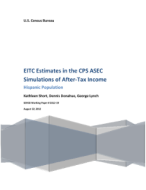
An official website of the United States government
Here’s how you know
Official websites use .gov
A .gov website belongs to an official government organization in the United States.
Secure .gov websites use HTTPS
A lock (
) or https:// means you’ve safely connected to the .gov website. Share sensitive information only on official, secure websites.
-
//
- Census.gov /
- Library /
- Census Working Papers /
- EITC Estimates in the CPS ASEC Simulations of After - Tax Income
EITC Estimates in the CPS ASEC Simulations of After - Tax Income: Hispanic Population
EITC Estimates in the CPS ASEC Simulations of After - Tax Income: Hispanic Population
Abstract
The Social, Economic, and Housing Statistics Division of the Census Bureau (SEHSD) regularly releases estimates of household income for the United States using information collected in the Current Population Survey Annual Social and Economic Supplement. As a part of this process, household income after taxes is calculated. The tax calculations use information on family relationships and reported income to simulate tax liabilities and tax credit eligibility for tax units. After-tax income is an important element in the estimation of the Supplemental Poverty Measure. Examination of the effect of the EITC requires information about the actual receipt of the EITC credit, while the tax simulator at the Census Bureau can only imply eligibility. There is evidence to suggest that take-up rates of EITC benefits differ by ethnicity and that among low-income parents Hispanics are less likely to have ever received the tax credit. This analysis uses the 2010 CPS ASEC matched to Tax Year 2009 IRS EITC data. Hispanic tax units are shown to be an important predictor of being a SESHD eligible non-participant.
Share
Related Information
WORKING PAPER
Supplemental Poverty Measure Working PapersSome content on this site is available in several different electronic formats. Some of the files may require a plug-in or additional software to view.
 Yes
Yes
 No
NoComments or suggestions?


Top

